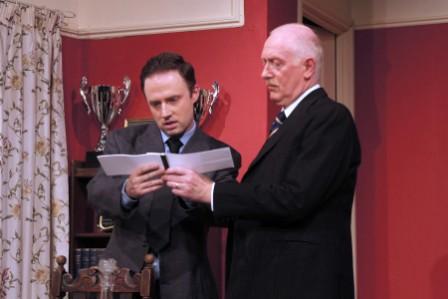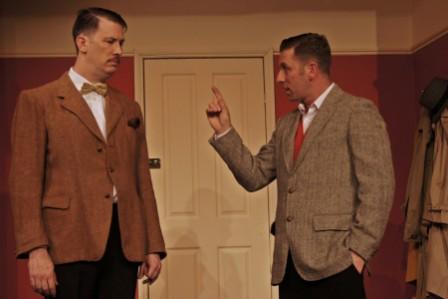|
|
||||||||||||||||||||||||||||||||||||||||||||||||||||||||||||||||||||||
Click
here for more pictures of this play |
||||||||||||||||||||||||||||||||||||||||||||||||||||||||||||||||||||||
|
||||||||||||||||||||||||||||||||||||||||||||||||||||||||||||||||||||||
|
Click here for the
NODA crit for this play |
||||||||||||||||||||||||||||||||||||||||||||||||||||||||||||||||||||||
|
It had been some years since I last visited Lopping Hall to see a show by the Loughton Amateur Dramatic Society and so I was looking forward to seeing the production of Frederick Knott's classic thriller “Dial M For Murder”. I was given a warm greeting by two delightful ladies who bade me “Good Evening” and directed me to an inviting bar area. The programme was included in the ticket price and was well produced and informative. I would have liked more information about the cast instead of simply their photographs. This would also have given me an idea of how experienced the actors were and helped me with this critique. The rest of the content was very good and I would have been happy to pay for the programme. On entering the auditorium the audience was able to see the set as the stage curtains were open. I felt this was a shame as the set was really good and would have given the audience more pleasure if it had not been revealed until the play started. Also, the actors could have been in place instead of being seen by the audience when they made their first entrance. The box set was realistic, practical and redolent of the fifties. We were given an occasional glimpse of a bedroom which adjoined the main living and acting area and this would have benefited from having a different colour of wallpaper. Set dressing was excellent and the clever use of trophies on display confirmed to the audience that the main character, Tony Wendice, had indeed been a top class tennis player. Accessories from the 1950's such as the telephone and radio were also spot on. Costumes also helped to fix the year of the piece and all seemed to be quite accurate. I particularly noticed Mrs Wendice wearing seamed stockings. Small details like this really do make a difference. Well done to Liz Adams on Wardrobe duties. The play required numerous different sound effects (telephone, radio, breaking glass, outer door etc.) and they were all well timed, at the right level and effective. Early on there was the sound of a striking clock which puzzled me a little as no clock was visible on stage. Perhaps we could also have heard the effect of rainfall for a short time when it was referred to. Overall though the sound design and operating team deserve congratulations. The lighting throughout was very bright. I think consideration should have been given to the additional use of table lamps which could have given some variety and been useful in changing the atmosphere occasionally. The fades between scenes and at the end of the play were effective as was the incidental music used during scene changes. The clearing of props and scene setting between scenes was also well done. Dial M For Murder is a wordy piece with a lot of exposition, particularly for Tony Wendice played by Lee Kenneth. He did very well in terms of lines (taking only one prompt to my knowledge) in what was a testing role. One could certainly believe in his character as the scheming, devious wife murderer and his ability to twist and turn when under pressure was very well played. Some of the longer, difficult speeches would have benefited from more variety of tone and volume as well as the occasional pause for emphasis, but overall the characterisation was excellent. When he was finally caught out and the game was up, his expression said it all. Karen Rogers as his wife, Sheila, also had a difficult role. Playing a woman who has survived a murder attempt, killed her assailant and then being convicted of murder presented a lot of challenges. Her character did need a more outward show of angst in view of the trying situation in which she found herself. Her turmoil needed more vocalising and was too underplayed which made it difficult for us to sympathise with her situation. Overall, however, Karen's performance was believable. Dean Bartholomew as her lover, Max Halliday, also started with a low key performance but seemed to grow in confidence as the play progressed. He certainly needed to show more concern about Mrs Wendice being condemned to death but picked up well when explaining his plan to get her off and played this scene with urgency and conviction. Captain Lesgate, Wendice's accomplice, was played by Adam Rabinowitz. Again, his performance was very laid back and while it was easy to believe in him as a scoundrel, he was too easily convinced by Wendice to become a murderer. He needed to convey more indecision before agreeing to carry out the deadly deed. However, it was an interesting interpretation of a tricky character to play. I thought the use of a pipe was valid but please rehearse the lighting of the thing a little more. Andrew Rogers as Inspector Hubbard certainly looked every inch the senior detective and his bearing and manner also bore this out. This was a confident, believable performance but lacked a little in variety and tone. His interrogation was done in one tone without change in pitch or volume and became somewhat monotonous. His stage presence however was excellent and I enjoyed the occasional moustache stroking which added to the characterisation. The above note about the use of a pipe also applies here. Every actor's diction and projection was excellent and even sitting near the back of the hall I could hear and understand every word. I understand that this was Howard Platt's first outing as a Director and he did a good job in bringing this difficult play to life. It's quite a well known story and many of the audience would have seen the film with Ray Milland and Grace Kelly and known the trick at the end. In spite of this the audience were kept in their seats and their attention was held. I'm not sure how much blocking of moves was carried out as there were occasions when the actors moved about the stage for no apparent reason other than to change the view we were getting of them. It did seem as though they moved because the director told them to, not because of any motivation. If this was done in accordance with stage directions from the script, remember that you don't always have to adhere to them. There were also scenes where two actors talked across to each other at the front of the stage which, if done for any length of time, seems very unnatural. Making more use of the upstage area would have helped. Upstage centre is the strongest position on stage and was used effectively by Inspector Hubbard. Similarly, early on in the play too much time was spent by characters sitting together on the sofa. There were definitely places in the conversation where one of them would have moved away. The early scenes were somewhat static, centreing around the sofa and much more use could have been made of the desk. Neither am I sure why the downstage chair was there as it was only used once. Exits were also sometimes too slow and tended to slow down the pace of the scene. In a wordy play of this type pace is important. Lines were delivered without hesitation and cues were picked up very well. However, a variety of pace is also critical and it sometimes helps to break scenes down into their highs and lows in order to find where the pace can be dropped and where it should pick up. Also remember that when someone enters into a room that is unfamiliar to them they need a moment to take in their surroundings. It was particularly noticeable that Inspector Hubbard knew immediately whereto hang his hat though he had never been there before. The scene where Sheila kills Captain Lesgate is extremely difficult to pull off and it didn't quite work. I'm not sure why. I couldn't see the scissors from where I was sitting which didn't help. Perhaps it needed more rehearsal and choreography. I have always maintained that the curtain call is an important part of any production as, no matter how good the show, a messy curtain call can be the last memory taken away by the audience. I was gratified that the actors took their well deserved bows simply and efficiently. All of these comments are said in the spirit of being constructive and should not be taken as an indication that I did not enjoy the show. I did and judging from the warm applause from the full house, so did everyone else. I'll certainly be coming to all future productions. Bernard Moule. 17th June 2017. |
||||||||||||||||||||||||||||||||||||||||||||||||||||||||||||||||||||||



